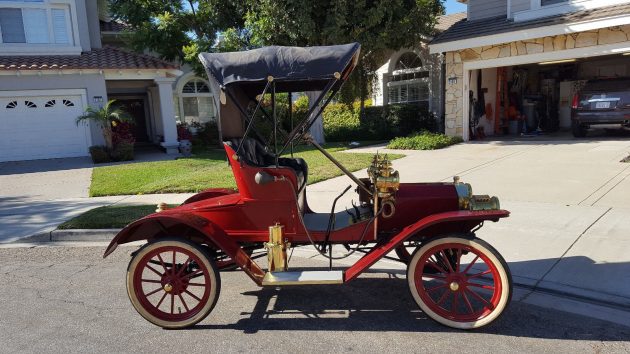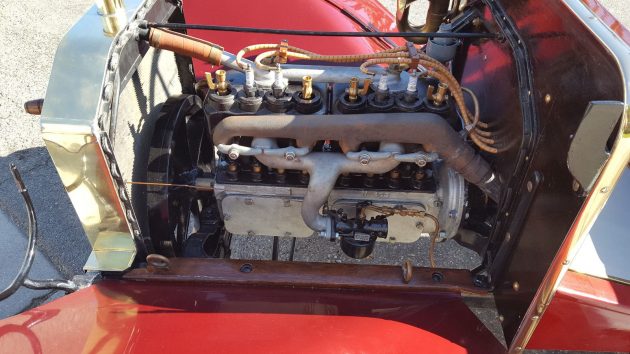This Ford Model S is listed on eBay is in Oxnard, California. At over 100 years old, it had to have been a barn find and restored at some time. With 5 days left the bidding is at $15,000 and the reserve is not yet met. The Model T is well known, but Models A through S are a mystery to most folks. These are the cars that evolved into the Model T. Some models were only experimental and never produced. Ford began with the original Model A in 1903 and the Model B in 1904. These had a horizontally opposed 2 cylinder engine under the seat. The Model N was the first model with an inline 4 cylinder engine in the front of the car. The Model S was introduced in 1907, as a bridge between the Model R and the Model T which was introduced the following year, in 1908. The Model S was basically a Model R with running boards, more elaborate body work and an optional rear seat. There are thought to be only 3 to 5 of the 2350 that were built in existence today. There is no history of this rare car. It could have perhaps been in a museum or a private collection. The seller has done a great deal of mechanical restoration but doesn’t mention any body work.
The engine and transmission have been rebuilt. The original parts were saved and are included.
The Model S was definitely restored at some time. Even up close the details of the bodywork and upholstery look really nice.
At a glance, one could mistake this for a Model T but they are very different cars. For example, the suspension is unsprung while on the Model T the front axle is supported by a transverse spring. It will be interesting to see what this Model S is bid up to. The California Automobile Museum listed a Model N needing restoration that was expected to sell for $8,000 and it sold for $40,000. Although nice Model Ts sell for $15,000, the early model Fords are rare and sell for much more. The museum’s 1908 Model T for example is said to be valued at $80,000. This is a beautiful example of an early Ford and will likely go to a private museum or collection. It would to be fun to have it in your garage for car shows and an occasional drive, would it not?




Old Cat in the background.
I like this car. I tend to think of the S as more like a K model with 4 cylinders. The N was much closer to the T.
The K was a completely different car from the N and S cars and the T was another big jump. We have a couple of Ks in the museum. They were built from the ground up as luxury cars. Ford did not build another 6 cylinder car for decades. You stand in front of the huge Ks and they are nothing like the other little Fords.
With only 3-5 left, wouldn’t this be worth a fortune?
“Old cat in the background” I was looking for an old Caterpillar tractor!. A little disappointed, actually.
Very cool.
Once again, rare does not mean valuable. It seems nuts, for example, that this would be less valuable than a restomod tri five. We are lucky that somehow been preserved. There are several of these rare Fords in the museum where there are just a few left, like the Model Ks, a first year T, the Model B and the mModel B, and visitors aren’t much interested.
Old cat in the background is a Vanden Plas Majestic Jag, top of the line XJ40 series for opulence. I’m a Jag guy, but I’d take the Model S, between the two. Early brass era cars may be hapless in today’s driving environments, but they evoke the happiness of a walk down Disney’s Main Street.
This old wagon ( before ford started making car) are ok to look at, but should be in a museum not driven sorry
Wow.
What an interesting car! I wonder how much was the old man’s engineering and how much employees? did he have other engineers at that time? (I know he was partnered with the Dodge Brothers in the early Ford Motor Company.)
I think it could be driven in US events like the British London- Brighton run.
Al
Un-sprung?
Look closely, there is a transverse leaf spring for the front suspension. Rears were two longitudinal elliptic (not half or quarter) springs. Given the conditions of the roads at the time even horse drawn vehicles usually had springs between the axles and wagon/carriage body.
The Dodge brothers were suppliers and early stockholders. I can’t say for certain they made no technical contributions but I’ve never heard of them mentioned as contributors in the overall design in any significant way. I’m sure as suppliers they at times had to make suggestions for changes in individual part designs for production feasibility.